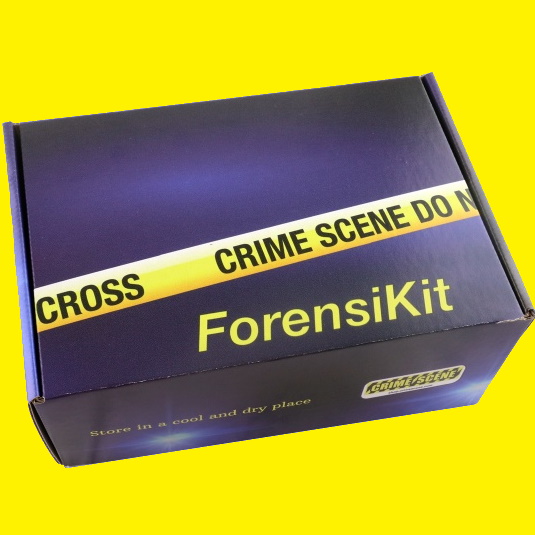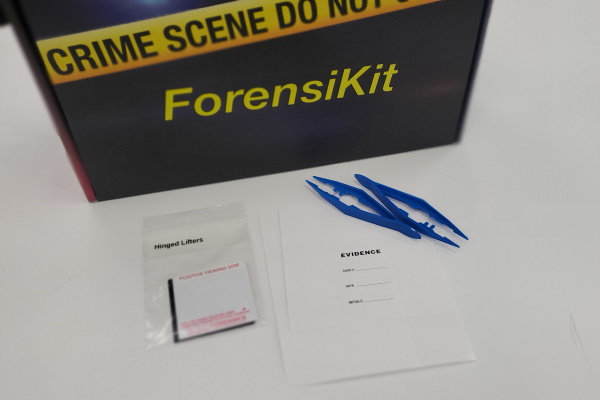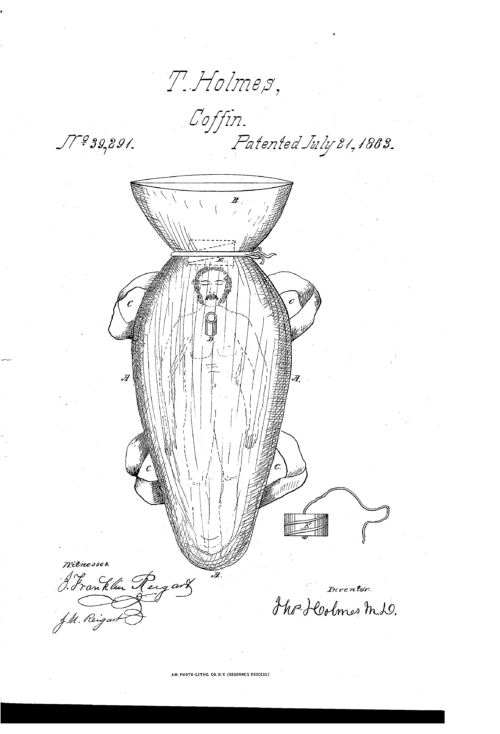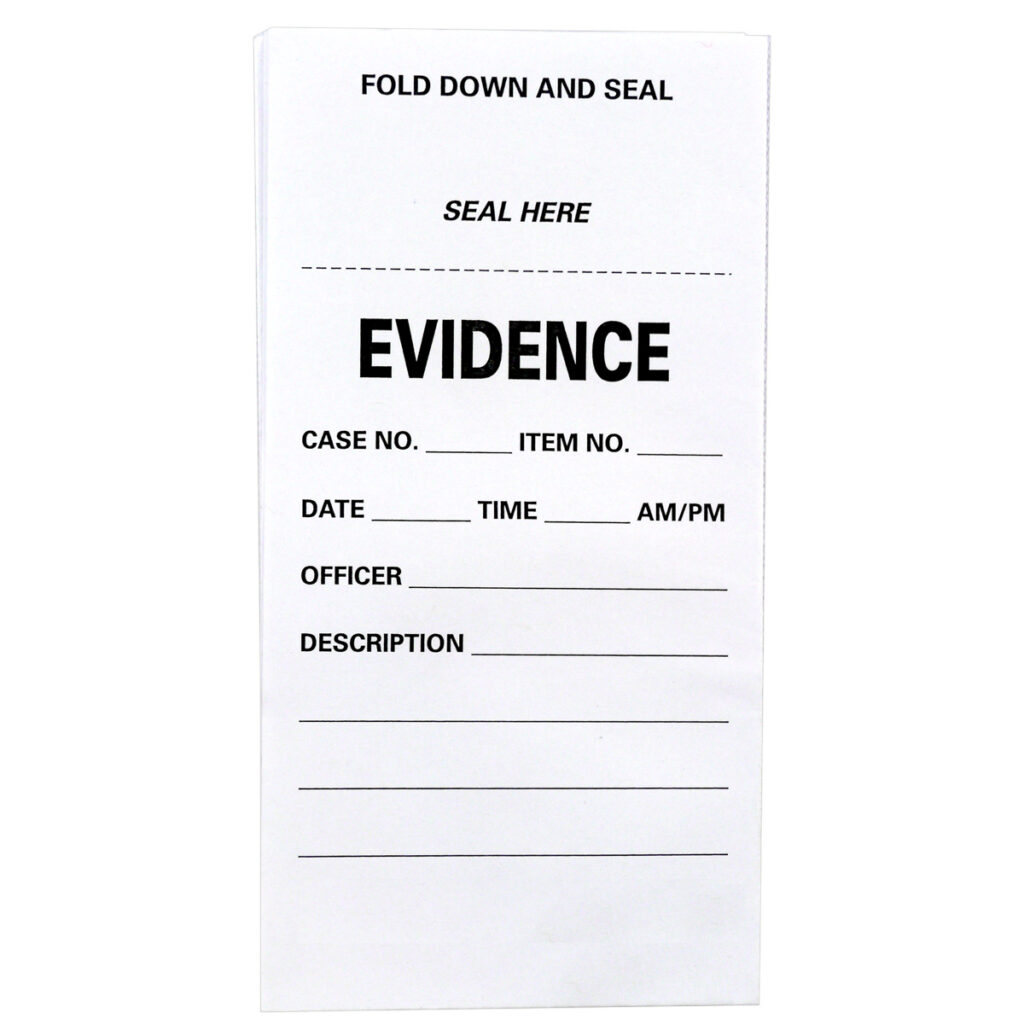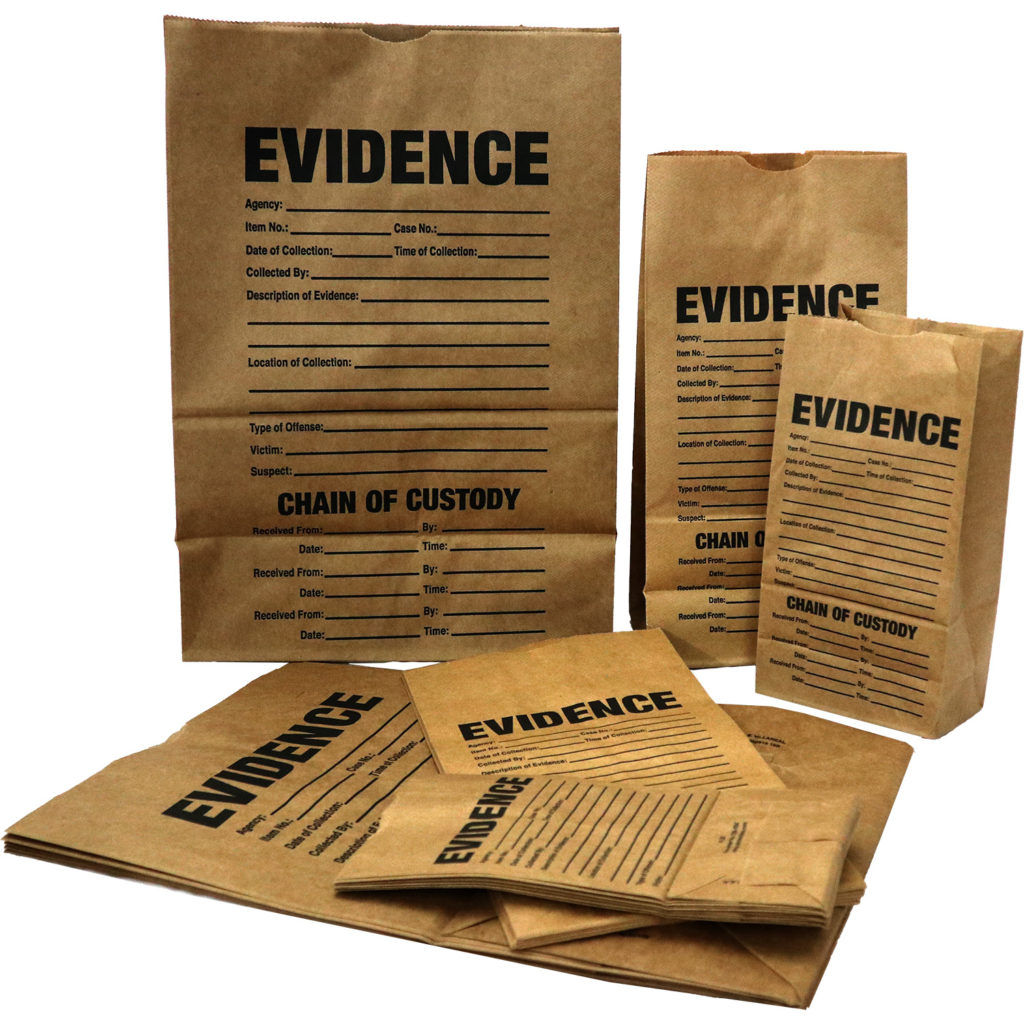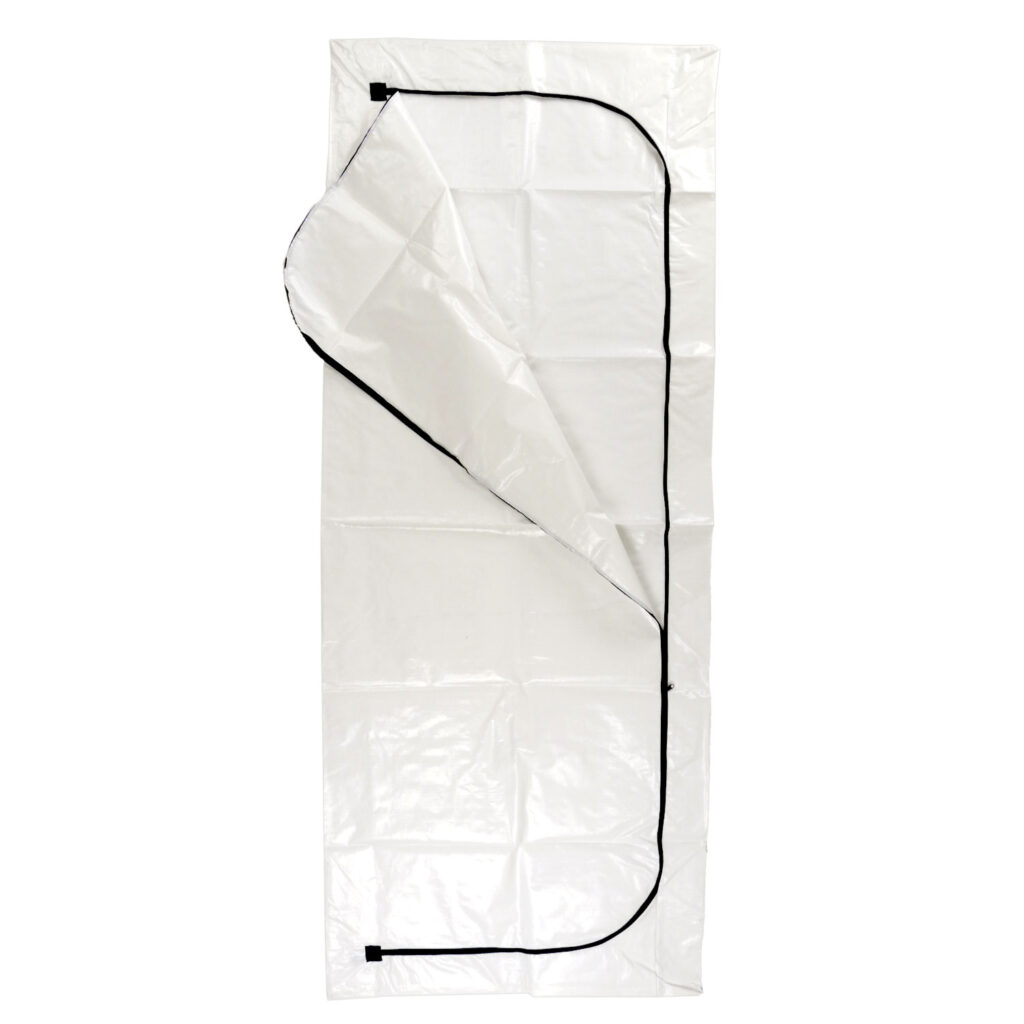The ForensiKit: Trace Evidence box includes
- One medium-duty body bag
- One BBID kit
- Five trace evidence folds
- Five feet of trace evidence tape
- Four 2×2 hinged lifters
- Two small paper evidence bags
- One 10-foot roll of evidence tape
- One small, wide-mouth jar with lid
- Two pairs of tweezers
- One pair of cotton gloves
- One activity insert (Download another copy [PDF])
- One packing list (Download another copy [PDF])
No subscription required
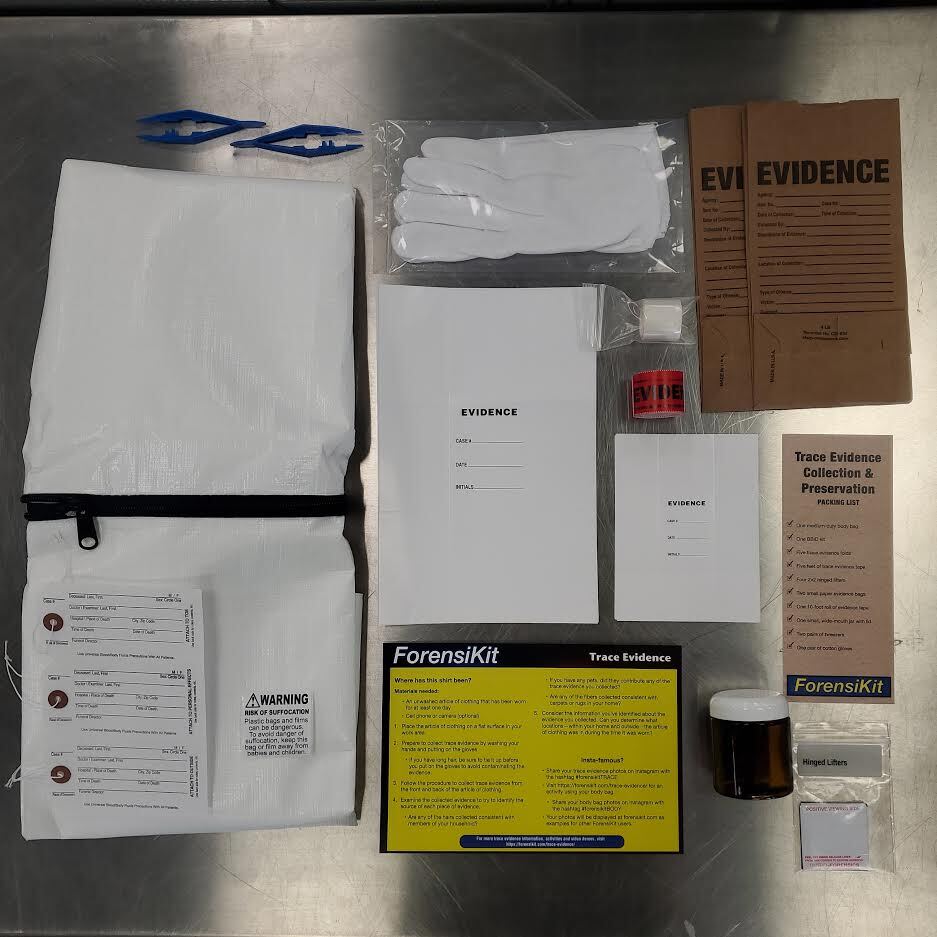
Activity – Bloody body challenge
Can you remove a body from a crime scene without transferring evidence from the body to yourself?
Materials needed:
- Sticky syrup or jelly (to simulate blood)
- A clean bedsheet
- Twin size will be easiest to manage, but any size will do
- 💡 Pro Tip: At a real crime scene, a plastic sheet may be used, but wrapping a living person in plastic is a suffocation hazard. Don’t do that.
- At least three people
- One volunteer to play the body
- 💡 Pro Tip: You’ll be doing yourselves a favor if the lightest person in your group volunteers to be the dead body.
- Two people to process the body
- One volunteer to play the body
- Cell phone or camera (optional)
Steps
- Ask your dead body volunteer to put some syrup on their hands.
- They can also put syrup on their face, limbs, etc. — whatever they’re comfortable with.
- Have your dead body volunteer lie down on the floor.
- They should choose a comfortable position because they may be in that position for a while.
- Fill out the three forms in your BBID kit.
- Toe tag
- Body bag tag
- Personal effects tag
- Write “Left” on one of the paper evidence bags.
- Carefully place the bag over the left hand.
- Try not to get any of the syrup on yourself and as little as possible on the bag.
- Use the evidence tape to secure the bag around the wrist.
- Repeat Steps 3–5 for the right hand.
- Attach the toe tag to “the body.”
- Spread out your sheet on the floor close to “the body.”
- Gently and carefully move the body onto the sheet.
- Use extreme care to avoid damaging any evidence—or your “dead body.”
- Wrap the sheet around “the body.”
- Do not cover the face of your living volunteer “body.”
- Spread out the body bag on the floor next to the body, unzip it, and open it up.
- Gently and carefully move the wrapped body into the body bag.
- DO NOT zip the bag fully closed.
- Attach the body bag tag to the body bag.
- Check yourself and your work area. Was any syrup transferred from the body to you or your work area?
- Photograph the body in the bag with the victim’s face visible.
- Share your body bag photos on Instagram with the hashtag #forensikitBODY
- Your photos will be displayed here at forensikit.com as examples for other ForensiKit users.
IMPORTANT
The body bag is a suffocation hazard. It is liquid and air-tight.
Never zip the body bag fully closed with a living person inside. They will suffocate.
The body bag cannot be opened from the inside.
Tips
- When moving a body, do not remove any items—clothes, personal property, ligatures, etc.—from the body. Leave them in place to be handled by the medical examiner.
- Always lift with your legs and not your back.
- When handling real human remains, always follow safety precautions.
- Wear heavy-duty gloves, a facemask, and PPE clothing.
- Wash thoroughly with antiseptic solution afterward.
[instagram-feed type=”hashtag” hashtag=”#forensikitBODY”]
Did you know?
When Dr. Thomas Holmes submitted his patent application for the first body bag in 1863, he described it as
“…an oval-shaped elastic receptacle, which is portable, having a funnel-shaped top, handles at the sides, a grooved block, and a tube for deodorizing purposes.”
US39291A – Improvement in receptacles for dead bodies – Google Patents
According to the patent application, in the accompanying drawing
- A — the elastic and deodorizing receptacle, made of India-rubber or other air-tight elastic cloth. It is oval-shaped, about 6 feet long, and about 2.5 feet at the widest part.
- B — The top is funnel-shaped, so a dead body may easily be inserted through the top, and so the receptacle fits to the shape of the body.
- C — two handles on each side, so the body can be carried by one or two persons.
- D — an aperture and tube attached near to the center of the receptacle, through which deodorizing substances are inserted to preserve the body for a short time until it can be embalmed or prepared for interment.
- E — a grooved round block in the neck of the receptacle. It is inserted in the receptacle after the body is inside to expand the receptacle and prevent it from touching the face and a cord is wound tightly around the outside to keep the receptacle air-tight.
[instagram-feed type=”hashtag” hashtag=”#forensikitTRACE”]
Additional Resources
- Body Recovery – National Institutes of Health
- Victim Recovery — what-when-how.com
- How is Trace Evidence Analyzed in Forensic Cases? – News-Medical.Net
- A Simplified Guide to Trace Evidence – Forensic Sciences Simplified
- Trace Evidence – FBI
